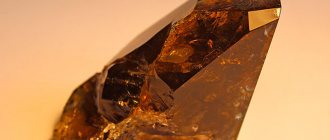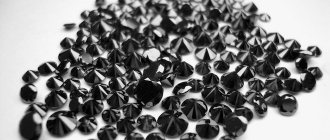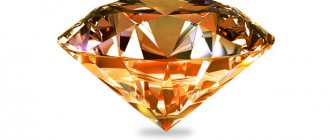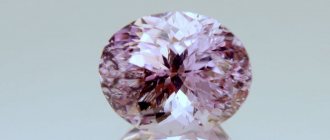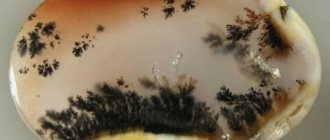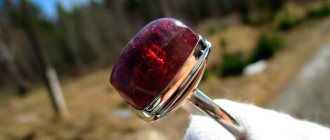Bright unusual shades are characteristic of many types of precious gems. The yellow stone is often chosen by jewelers because of its sunny, sparkling color. Most people associate it with joy, love of life and wealth, so products with this mineral are often given as gifts to dear and significant people.
Crystals of a golden hue are often endowed with magical properties. A striking example is the yellow infinity stone, responsible for the sphere of the mind, from the famous Marvel franchise.
In the culture of many nations, yellow gemstones are considered the personification of the sun, therefore mystical and healing properties are attributed to them.
Diamond
The value of this crystal is due to its rarity. Only 1 in 100 thousand natural diamonds will have an amazing golden hue. In this case, the color can vary from pale yellow to bright lemon. The cost of a stone directly depends on the intensity of its color.
A golden tone is a sign of the presence of nitrogen impurities in the composition. Secondary shades visible in the palette can be orange, brown and greenish. In this case, the first one raises the cost of the mineral, and the remaining two reduce its price.
An artificial yellow diamond is created in a laboratory under two conditions: high temperature (1500°C) and pressure.
More than half of the stones of this color on the market today are synthetic. They are called moissanites.
The main places of production are Angola, Brazil, Australia, Tanzania, Borneo, Sierra Leone.
Interesting! The cost of the most expensive yellow diamond, the Shard of the Sun, weighs 110 carats and is worth more than $12 million.
Sapphire
The color palette of sapphires is very diverse, but the yellow tint is quite rare. Gold sapphires are processed using the same cut forms as diamonds:
- "pear";
- "princess";
- "cushion";
- "marquis";
- "heart".
Sapphire is mined in Burma, Afghanistan, Madagascar and Sri Lanka.
The golden type of corundum is often used by jewelers as precious inserts in exclusive jewelry.
Uniformly colored yellow sapphires are extremely rare. In most cases, such specimens are synthetic analogues created in laboratories in Japan, Russia, the USA and China.
Golden topaz
Transparent stone of a sunny tone is very popular due to its unusual color and not the highest cost. Rare specimens of this mineral are polychrome, that is, they exhibit additional tones: pink, brown and greenish.
Precious topaz inserts can often be found in rings, earrings and pendants. Jewelers often use it as an additional frame for diamonds or emeralds.
Varieties of golden topaz:
- imperial (yellow, yellow-brown);
- nitrogen (orange-yellow);
- mystic (artificial with tints from yellowish to green).
The mineral is mined in Mexico, Brazil, the United States and Burma.
Spinel
The golden-hued variety is often found in India and Afghanistan. The stone is distinguished by a faint, washed-out yellow tone and, despite its rarity, is not as sought after by jewelers as topaz.
However, the high degree of transparency and refractive index make spinel excellent for use as an addition to diamond jewelry.
Heliodor
Rare translucent golden beryl species are called heliodors. The honey tint is the result of iron inclusions. The gem is mined in Argentina, Namibia, Brazil and Madagascar. There are deposits in Russia as well.
Most often, natural heliodors are set in gold and combined with rarer types of precious stones.
Must See: Rare and Valuable Green Diamond
| Name yellow stone | Origin | Characteristics | Price per 1 carat (in rubles) | ||
| Color | Chem. compound | Hardness | |||
| Diamond | one form of carbon | light to deep yellow | carbon and nitrogen inclusions | 10 | from 110 thousand |
| Sapphire | variety of corundum | lemon to yellow-orange | aluminium oxide | 9 | from 45 thousand |
| Topaz | aluminum silicate | lemon to light brown | aluminum impurities | 8 | from 15-18 thousand |
| Spinel | magnesium aluminum oxide | pale yellow, transparent | inclusion of chromium | 7,5-8 | from 14 thousand |
| Heliodor | beryl variety | from light yellow to honey | iron impurities | 7,5-8 | from 3 thousand |
The rare color affects the cost of the stone, but quality characteristics, such as purity and uniformity of shade, also play an important role.
The meaning of yellow
Cheerful sunny minerals include examples of orange, gold, lemon, honey, and light and dark yellow. These colors are perceived as bringing light, happiness, warmth and love. Perhaps this is why yellow stones give a person optimism and positive emotions, and the Japanese believe that this color gives willpower and courage. For the ancient Egyptians, yellow was associated with the supreme god of the Sun - Ra, was expensive and was inaccessible to “mere mortals”.
Gems are divided into precious (which are less common) and semi-precious (which are found more often). Another factor that adds value is quality.
Substances that give color to minerals are sulfur, iron and lithium. The exception is amber, whose color is determined by the resin content.
There are opaque, translucent and completely transparent samples. This also determines the price, while stones of yellow tones are less common in nature than, for example, red or blue, and, accordingly, are more expensive.
Assortment of minerals
The names of yellow stones appear in all jewelry segments. Their range is created by impurities of lithium, aluminum, sulfur or iron. In amber it is a shade of natural resin.
Precious
Among the stones of the first level there are no simply yellow ones, but there are such varieties.
Diamond
Yellowishness is considered more of a flaw in transparent, colorless diamonds. However, rich color is rare. Out of a hundred thousand pebbles mined in the world, only one is found. This color is the merit of lithium. The more it is, the more intense the shade and the higher the cost of the stone. More about the diamond.
Yellow diamond ring
The number one yellow gemstone is the Sancy Diamond. Named after the first owner Nicolas de Sancy (XVI century). Later it was owned by the Russian princess Aurora Karamzina.
Sapphire
The classic color of this expensive variety of corundum is blue. Yellow sapphire is rare and comes in a range of shades from lemon to amber. The color is often heterogeneous, with iridescence and darkish stripes. It is created by aluminum impurities.
A yellow stone without inclusions from Sri Lanka is especially valued.
Necklace with yellow sapphire
The gem is protected by Jupiter, so you can wear jewelry with it on the eve of your 36th birthday. During this time, the planet revolves around the Sun three times, becoming as useful as possible to humans. Such a sapphire is powerful if given as a gift (including to yourself).
Semi-precious
There are several types of yellow stones of this jewelry value.
Topaz
The entire topaz family owes its name to this variety: “tapas” means yellow.
It was found first, the most common, and regally beautiful.
Transparency, strong brilliance, and full range of tones make it similar to citrine. Yellow is the natural color of the mineral. Others are rare or produced by heating.
Amulet with yellow topaz
The natural variety of topaz is called imperial - a bright, rich yellow-orange or orange-brown transparent stone.
Unlike other gems, the color of topaz does not depend on impurities. It is created by defects in the crystal structure. Yellowness results from the replacement of iron atoms.
Tourmaline
Yellow (along with blue) tourmalines are rare, most often the stones have a pink-crimson color scheme.
Stones with shades ranging from light yellow to brownish are called dravites. They are supplied only by Africa (Kenya).
Brown-yellow tourmaline
Color saturation, transparency, purity determine whether it will be a semi-precious stone or an ornamental one.
Citrine
A transparent, bright golden variety of quartz. Yellow color creates iron. Depending on its amount, the color varies from light lemon to rich, dark orange (such samples are called “Madeira”). A similar effect is obtained by calcining colorless samples.
Beads with citrine
Yellow jewelry quartz is less common than colorless quartz, it looks better, and therefore is more expensive and popular.
Industrial-scale mining is carried out in Brazil, the USA, Russia, and France.
Zircon
Natural stone is transparent, with a diamond shine. Also known as "Yargon". The color scheme is golden or yellowish. Yellowish specimens undergo heat treatment, becoming red (hyacinths), turquoise (starlites) or greenish.
Zircon
It is fragile, so zircon is not particularly in demand among jewelers.
Production has been established in Russia (Ural, Yakutia), Thailand, Norway, Canada, and Madagascar.
Heliodor
Heliodor is a transparent, honey-colored variety of beryl created by an admixture of iron. Its second name is “yellow beryl”. Translated from ancient Greek - “gift of the sun”.
Ring with Heliodor stone
The most expensive ones are rich yellow or amber. Specimens with a grayish, slightly yellowish tint are valued less. This is a heat treatment object that makes them conditioned.
Heliodor is often confused with citrine, topaz or quartz.
The favorite material of jewelers is stones of a natural golden hue. They are mined in Russia, India, Ukraine, Brazil.
Pomegranate
The classic stone is a deep red to burgundy color. Yellow is atypical and rare. The dark yellow stone is called andradite. Processed cabochon. We wrote more about pomegranate here.
Andradite stone
Ornamental
There are no exclusively yellow natural stones in this segment, only varieties.
Amber
Instances of sunny orange and yellow-brownish colors are considered amber classics; they are the most common (unlike black, white or green). Almost all amber raw materials are mined in the Baltic. The following types of mineral are endowed with this color: gedanite - yellow, fragile, therefore it is not processed, but is used as a collection material; kissellite – yellow, olive, green amber; shraufite – yellow-red or red.
Product made from natural amber
Jewelers use succinite - the highest quality type with a high percentage of succinic acid. It is dark brown with a deep yellow center.
Cornelian
A variety of quartz from the chalcedony group. The origin is volcanic, the color is uneven - striped or with other inclusions.
Cornelian
The orange-yellow and yellow variety of ornamental stone is called “lincurium”. To increase the color intensity, the mineral is heated.
Transparent and translucent specimens go to jewelers. A pendant with such carnelian is a good children's talisman.
Jasper
The opaque yellow variety of the full range (from pale to thick, even with a brownish or greenish tint) is common and affordable. It can be plain or with veins, patterned, “brocade”.
Jasper
It is durable, so it is suitable for all types of jewelry and decorative items (boxes, candelabra, stands, tabletops). It looks luxurious, Russian deposits are concentrated in the Urals and Altai. We wrote more about jasper here.
Agate
The yellow-reddish-brown color of agate is created by iron impurities. This is one of the most common agate shades. Yellow range with colors ranging from light coffee to brownish brown.
Yellow agate rings
Since Antiquity, the golden stone with sparkles has been valued as a source of inspiration and vitality. Travelers and merchants took yellow agate with them. They believed that a ring with an agate signet would help win the lawsuit.
Apatite
Phosphate mineral of different colors. Yellow apatites are distinguished by glassy luster and transparency from complete to zero.
Apatite
Jewelers use transparent, rich yellow stones with a diamond shine. They are usually no larger than five carats, with outstanding specimens being three to four times as massive. They are mined in Sri Lanka, Myanmar, Canada, and Italy.
Sphalerite
A sulfide mineral, also known as zincblende: its lemon coloring makes it similar to honey. Read more about it here.
Sphalerite
It is practically not in demand by jewelers due to its fragility. Jewelry is made to order and is very expensive. Raw materials suitable for processing are supplied by Mexico and Spain. More popular as a collector's item.
Nephritis
The classic mineral color is green. Yellow jade is rare and especially loved in China. The color range includes shades of yellow from light to deep dark.
Yellow bracelet with jade
Honey jade, with a rich yellowish-brown range of shades, is valued by rulers and ordinary Chinese. First of all, as a material for home interior products. Suitable for water signs of the zodiac.
Artificial
The rarity or high cost of golden minerals prompted people to create artificial stone:
- has been established at the Kaliningrad Amber Plant . This artificial amber is obtained from natural resins and is identical to natural stone.
- The “understudy” of natural mystic topaz is called nitrogen topaz . This is an iridescent orange-yellow artificial mineral, popular due to its affordable price and decorative properties.
Analogs of natural minerals exist for all types of stones; they are used mainly for jewelry.
Precious minerals
The following yellow precious minerals can be distinguished:
Diamond
One of the rare gems of the world. Among the diamonds mined, only every hundred thousandth specimen is yellow in color. It is a clear crystal; shades of diamonds are light yellowish, bright lemon and golden, there are even tangerine shades. The gem is very expensive, for example, a 13.4-carat specimen was sold at auction for 3 million (in 1997).
Sapphire
The classic color of the stone is blue; yellow crystals are rare, with shades ranging from light to golden amber. There are specimens with such a pale color that they are classified as colorless. The minerals are unevenly colored; stripes and inclusions are usually darker than the main tone. Stones of pure color are rare, so they are expensive. The places where sapphires are mined are the islands of Madagascar and Ceylon, as well as Burma.
Topaz
This is a transparent crystal with a natural yellow color. There are polychrome samples containing brownish or greenish tints, but this is rare. The color of the crystals may change from yellow to pink (during heat treatment). This procedure is carried out in laboratory conditions. Topaz fades when exposed to direct sunlight, so items lose color over time.
Tourmaline
The standard color of the mineral is crimson; precious yellow stones are rare (they are called drayites). The shade is often uneven, with blue, pink or brown inclusions. Depending on the color saturation, transparency and frequency of inclusions, tourmaline is also classified as semi-precious or ornamental minerals. Currently, production is carried out only in Kenya.
Traditional varieties
Yellow stones are classified according to the parameters of structure hardness and abundance. Conventionally, precious and semi-precious minerals, decorative and ornamental gems are distinguished.
Semi-precious
Masters of jewelry art have a genuine interest in representatives of a large group of semi-precious minerals the color of the sun.
Zircon
A brittle mineral with a yellow tint, zircon is considered a natural substitute for diamond due to its corresponding brilliance and impeccable transparency. Due to its significant fragility, the gem is rarely used as inserts in jewelry. This is the stone of entrepreneurs and representatives of the scientific world. You should beware of opaque crystals, as they often have an increased radioactive background, especially for bright green zircon.
Yellow zircon
Heliodor
Yellow beryl, also known as heliodor – from the Greek “gift of the sun” – owes its honey-like hue to an admixture of iron. During heat treatment, the crystal initially becomes colorless and later acquires a blue color. The captivating beauty of heliodor is fraught with danger due to the radioactivity of the gem. Jewelry with small crystals is safe, since the radiation of small pieces does not exceed the norm. At the same time, it is risky to acquire boxes, vases and decorative figures made of honey beryl. The radioactive background of a nugget varies greatly depending on the intensity of the color, so light yellow heliodors are a priority.
Yellow beryl is called the stone of joy and joy. It helps relieve stiffness and helps relieve emotional stress. The unique healing properties of heliodor make it possible to stabilize the functions of the cardiovascular system.
Citrine
The gem is a type of quartz, has a glassy luster and a stable color. Specimens without inclusions are very rare; citrine with a homogeneous structure and a pure spectrum is highly valued among jewelers. In ancient times, amulets and jewelry with golden citrine were worn to attract wealth and success.
Precious
Jewelry with yellow precious stones is especially popular among aesthetes and lovers of exclusive jewelry. Crystals of this group are not often found in nature and are highly expensive.
Diamond
Diamond deposits are located in subsoil layers with very high temperatures. The yellowish crystals contain significant nitrogen impurities. The collections of precious nuggets feature unique examples of rough diamonds. The following legendary diamonds are known in the world of jewelry:
- Allnatt – a bright yellow diamond adorns a jewelry composition in the form of a flower with petals, stem and leaves made of platinum. The item sold for $3 million at Christie's;
- “Sancy” is a light yellow diamond with pinkish tints in the shape of a droplet, presented in the collection of the Louvre, found in India in 1570;
- The Florentine, also known as the Australian Yellow Diamond, is a lemon-colored diamond of 137.27 carats.
Diamond hardness is rated at 10 on the Mohs scale and is difficult to process. However, diamonds are very fragile. Mechanical impact causes a crack or chip to form on the stone. A deformed crystal loses its healing and magical properties.
Sapphire
A variety of corundum - sapphire - is rare in yellow color; most often the mineral is found in bluish shades. In terms of hardness, it is second only to diamond, and also demonstrates high strength. The main deposits of golden corundum are located in Sri Lanka. Yellow sapphire of high spectral purity is highly valued, since the structure of the predominant part of the samples is heterogeneous. In Ayurveda, the crystal is known for its ability to give the owner a state of peace; it is actively used in meditation.
Yellow sapphire
Tourmaline
Dravite - yellow tourmaline - is rare, which is why it is valued more than its relatives of other tones. Basically, the structure of dravite is heterogeneous and has inclusions. The hue of golden tourmaline varies depending on the intensity of lighting and the direction of the light rays. It contains potassium and magnesium. Due to the high strength of the volcanic rock, it is difficult to leave scratches on dravite.
In jewelry, crystals of 2 carats or more with a uniform spectrum and level of transparency are in demand. Specimens with significant weight are relevant in the production of radio engineering: dravite is used in electronics, robotics, and optics. The mineral is actively being introduced into the medical industries.
Topaz
Sun Topaz displays a bright yellow color with an iridescent glow. Crystals with the property of polychrome with tints in red, brown, green tones are rarely found. In Sanskrit, the name of the stone means “warmth”. The honey tone of topaz shines with glassy shimmer, but under the influence of UV rays the crystals fade.
Gemologists distinguish the following varieties of gems:
- topaz imperial in orange-brown or yellow-orange color;
- nitrogen topaz with beautiful orange-yellow tints;
- mystical topaz with a rainbow tint.
In ancient times, the nugget was credited with the properties of treating various ailments of the liver and kidneys, and was used for viral diseases and for conceiving a healthy baby.
Decorative and ornamental types
This category of yellow stones is distinguished by its opaque structure and lack of glassy luster.
Amber
A unique gem whose age ranges from 35,000 years, it is considered a stone of longevity. Fossilized softwood resin is rich in trace elements, especially iodine. Amber is actively used as a healing agent in the prevention and treatment of thyroid diseases and other ailments. The solar mineral is considered a powerful amulet against troubles.
Agate
Yellow agate owes its golden color to natural inclusions in the form of iron oxides. The gem tends to shimmer in a variety of shades. Agate is known for its multi-colored structure; the mineral always contains inclusions and patterned lines. Beads made of yellow agate can neutralize inflammation of the throat, earrings with a gem help relieve toothache, and bracelets can eliminate pain in the joints.
Nephritis
Jade with a golden hue is rare. Beads of various shapes are made from opaque crystals. Nuggets processed in cabochon form are used as inserts in pendants, bracelets, rings, and earrings. In the old days, jade gained fame as a healing remedy for kidney ailments. It was also credited with healing properties against tissue inflammation, and jade was used as a pain reliever during childbirth. It was used in powder and liquid form, and the face and body were massaged with pieces of sunstone.
Yellow jade
Semiprecious stones
The following semi-precious yellow stones are distinguished:
Heliodor
A gem of rich golden tones. There are samples of honey color, the brightness depends on the amount of iron impurities. Heliodor means “gift of the sun” in Greek. Another name for the stone is yellow beryl. This is a transparent crystal, which is usually used in its natural form. However, if the color of the specimen is unsaturated or interspersed, the minerals are subject to heat treatment. This causes the gem to become transparent or change color to bluish. Heliodor deposits have been discovered in Russia, India, Ukraine and Brazil.
Citrine
A variety of quartz with rich tones (from light lemon to bright orange). There are dark orange specimens called Madera. The crystals are mostly half or completely transparent, yellow stone is rare. Therefore, some citrine is grown in laboratory conditions. Natural gemstones are mined in the USA, Russia (in the northern part), as well as in France and Brazil.
Zircon
Natural stone is transparent, hard and with a pronounced shine. Also goes by the name "Yargon". Colors are yellowish or golden. After heat treatment it turns greenish, turquoise or red. Zircon deposits are located on the island of Madagascar, Canada and Thailand. In Russia, deposits of the mineral were found in Kamchatka, Yakutia and the Urals.
Pomegranate
The yellow color is not typical for this stone, but such specimens do occur. Mined in small quantities. Garnet is used to make rings, earrings, and beads; the cut is made in the shape of a ball or oval. Medicinal properties include a positive effect on breathing and joints, as well as the ability to regulate high blood pressure.
Gems
Diamond
Yellow diamonds are also called “golden tears.” In the past, orators and priests wore gems in gold.
The density of the mineral is 3.51 g/cm³, the Mohs scale is 10. The level of transparency depends on the purity of the diamond.
The main mining of the gem is carried out in Russia (in the Republic of Sakha) and in Botswana. The cost of 1 carat yellow diamond is $2,500.
Famous yellow diamonds:
- Sancy (55.23 carats) - a yellow-pink diamond named after a Frenchman who acquired it in the 16th century in India. Kept in the Louvre Museum.
- Florentine is a bright yellow color, imported from India.
- The golden Tiffany diamond is the famous symbol of the jewelry house. The brooch consists of a yellow mineral on which a bird is located.
Sun-colored diamond jewelry is suitable for people born under the Air sign. For them it is a symbol of success and prosperity. Gems will help Capricorns in their career. It is not recommended for Pisces to wear them.
Sapphire
The stone comes in a wide range of colors, but what makes it yellow is the admixture of iron without titanium. The color scheme varies from pastel to bright, sunny. This sapphire is popular in India as a sacred sapphire.
Sapphires are transparent, translucent and with complete loss of transparency.
Deposits of the precious mineral are located in China, Madagascar, and Thailand. Transparent stone cost: $100-130 per carat.
Yellow sapphire will bring good luck to Aquarius and Sagittarius. Capricorns are contraindicated from wearing jewelry with gemstones.
Tourmaline
The crystal of volcanic origin is mined in Sri Lanka and Tanzania. Color range: from light yellow to brown-yellow. Tourmaline changes shade in the sun.
Tourmalines of varying degrees of transparency, inclusions are rare. The average cost is $50 per 1 carat.
Tourmaline is suitable for Scorpios. Contraindicated for Taurus and Virgo.
Topaz
A transparent gemstone with a distinct shine. Shades vary from light yellow to brown. It is mined in Sri Lanka, and more recently in Ukraine (at the Volyn deposit). The cost of 1 carat starts at $50.
The beneficial effect of the gem on the body was known back in Ancient India. Lithotherapists believe that yellowish topaz helps in the treatment of tuberculosis, bronchitis, and asthma.
Golden-hued topaz is suitable for 12 zodiac signs. But it will bring complete prosperity in life to Gemini.
Decorative and ornamental
Representatives of this group are usually opaque. This is the main difference between gems and precious or semi-precious ones.
Cornelian
A variety of quartz belonging to the chalcedony group. The origin of the stone is volcanic, the color is often uneven, with stripes and inclusions. In terms of healing properties, the mineral is similar to other representatives of the “yellow” group; it has a beneficial effect on the stomach, digestion and thyroid gland. Carnelian is mined in China, where it is considered a stone of longevity.
Amber
A gem of sunny bright tones, its origin is the petrified resin of ancient coniferous trees (over 100 thousand years old). Coloring - gold, honey, yellow and orange tones. Amber deposits have been found on the Baltic Sea coast. The stone has strong healing and magical properties and is used in the treatment of a number of diseases (including the thyroid gland) and as a talisman.
Jasper
An inexpensive ornamental stone used to create necklaces, bracelets, earrings and rings. Gives jewelry a luxurious look (despite the low price). Jasper comes in shades of yellow. There are also yellow-green tones.
Agate
A popular ornamental gem with various shades of yellow: light, lemon, brownish. Natural samples often contain inclusions and stripes. Laboratory-grown agate has a purer and richer color.
Nephritis
The yellow color is atypical for this gem; green stones are more common. Jade crystals are opaque; to make necklaces and beads, they are polished, and for earrings and rings, they are processed using the cabochon technique. Shades of yellow - from light to dark, deep and rich.
Ornamental gems
Apatite
The name of the mineral is translated from Greek as “deception.” The yellow ornamental stone has the properties of a chameleon, which is why it is confused with tourmaline, amethyst, and aquamarine.
Apatite is transparent, some samples have opacities. The deposits are located in Spain, the USA, South Africa, Norway, and Mexico. The cost of 1 carat is 11 dollars.
Let's combine the gem with the signs Sagittarius and Leo. Apatite is not suitable for Pisces.
Agate
In ancient times, dishes were made from this opaque ornamental stone, amulets and talismans were made. Large deposits of the solar mineral are located in Tajikistan, the Caucasus, Primorye and Eastern Siberia. The price of 1 carat is 5 dollars.
Agate will bring happiness and success to Taurus and Virgo. It is strictly contraindicated for Sagittarius and Aries.
Sphalerite
Yellow sphalerite has a metallic or diamond luster and crumbles when processed. The mineral is mined in the USA, Russia, and Spain.
Sphalerite is either transparent or does not transmit light. A piece will cost $5.
The mineral is suitable for all signs of the zodiac circle, but astrologers do not recommend it for Scorpios.
Amber
The shades of the mineral vary from golden yellow to orange. Amber melts at a temperature of 350 degrees Celsius.
Amber is mined in the Kaliningrad region and the Dominican Republic. Russian gemstone is valued more due to its older age.
Transparent, translucent and opaque amber is found in nature. The cost of 1 gram ranges from 80 to 100 dollars.
Amber is useful for Leos, Sagittarius and Aries. It is strictly contraindicated for Taurus.
Nephritis
The mineral is revered in China. There are translucent, transparent and translucent specimens, the shine is silky or greasy. The stone is mined in Russia, Taiwan, China, and Australia. A kilogram of jade costs from 200 to 10,000 dollars.
Jade is compatible with 12 zodiac signs, but is ideal for Libra.
The rest of the information is in the article “Jade stone: varieties and properties.”
Magical and healing properties
It is known that yellow gemstones have strong energy and have a beneficial effect on humans. Crystals give a charge of vigor and optimism and fight a number of diseases. It is believed that the greatest power comes from transparent semi-precious and precious minerals.
Wearing items with yellow gems is recommended:
- people with digestive problems;
- patients with stomach and intestinal diseases;
- to improve the condition of the heart and blood vessels;
- with high blood pressure;
- to relieve tension (especially from the eyes).
Esotericists endow stones of solar shades with magical powers, so they contribute to:
- cheerfulness and gaining a positive outlook on the world around you;
- building willpower and self-confidence;
- strengthening relationships with friends and colleagues;
- peace and harmony in the family;
- protection from ill-wishers.
general characteristics
Medicinal properties
Lithotherapists believe that yellow stones have a number of healing properties:
- increase stress resistance;
- restore mental balance;
- improve memory;
- treat insomnia;
- inspire creativity;
- increase immunity;
- improve vision;
- block pain;
- speed up metabolism;
- strengthen the overall tone of the body;
- improve blood circulation;
- slow down the aging process.
Magic properties
Yellow stone is a symbol of energy, life and youth. He is able to change despondency and sadness to warmth and joy.
Bioenergeticists believe that yellow minerals attract happiness and good luck in all endeavors, rejuvenate the body and soul, and protect travelers from dangers.
Stones of sunny shades treat depression and lift your spirits. They are suitable for modest and shy people and help them to relax. Unconfident individuals are given determination and self-confidence.
Jewelry made from yellow-green gems improves your financial situation, maintains harmony and peace of mind. They help to concentrate, concentrate attention, improve memory and give a thirst for knowledge.
A gem next to the bed or under the pillow gets rid of nightmares.
The owner of the yellow gem will learn to recognize liars.
However, sun stones only help people with good, noble intentions.
Classification
In the jewelry industry, yellow minerals are divided into precious, semi-precious, and ornamental.
Based on the degree of transparency, stones are classified into transparent, translucent and opaque.
Let's look at the features of common yellow gems from different categories.
Yellow stones and zodiac signs
The color of the minerals of this group represents brightness, sun and warmth, so they are most suitable for representatives of the element of Fire (Sagittarius, Aries and Leo). Yellow gems will charge you with additional energy, make you more cheerful and confident, and transparent stones - sapphire and topaz - will calm emotional natures and give wisdom and sound thinking.
Women - representatives of the fire signs of the Zodiac - will receive peace in the family and smooth, warm relationships with loved ones, and men will receive success in business and career growth. “Cheerful” minerals will help you establish business contacts with partners and conclude profitable deals.
The only sign for which yellow crystals are not recommended is Scorpio. The rest can fearlessly choose and wear them as a talisman.
Solar scattering on Earth
Yellow shades of minerals are rare in nature. Stones vary in appearance, composition and use. The different shades of yellowness of lemon, golden, honey, orange, and light brown stones are due to the different content of lithium and sulfur in them. Only the amazing honey color of amber is the result of fossilized resin from pine trees growing millions of years ago. A small number of yellow mineral deposits are known.
Transparent, translucent and opaque minerals are found in the deposits. Transparent yellow stones are of particular value. They are expensive, used for making jewelry, and delight with their appearance, brilliance, luxury and beauty. According to their properties and appearance, application and use, yellow crystals are divided into:
- precious
- semi-precious
- decorative.
Jewelry with yellow stones
Colored minerals have long been in demand for creating jewelry. Craftsmen often use yellow precious and semi-precious stones for their work. Multi-colored transparent crystals are especially valued, giving the products luxury and elegance. These are, for example, jewelry with yellow sapphires, diamonds or topazes, and often gems of golden and honey tones are adjacent to samples of other tones.
Ornamental and decorative specimens are used to make beads, earrings, necklaces, rings and pendants. Gems, for example, representatives of the chalcedony group, are used for interior decoration, inlaying vases, paintings and mirrors.
Caring for products made from natural minerals is not difficult. In order for things to maintain their appearance and please the eyes of others, it is enough to follow simple rules:
- avoid contact with cosmetics and perfumes;
- store in special jewelry boxes;
- do not use chemicals for cleaning (only soap and water);
- Opaque samples should be wiped with a soft cloth from time to time to maintain shine.
Bright sunny stones will decorate every person and his home, give vigor and awaken interest in life. And with proper care, they will remain attractive and give their owner their positive energy.
Magical properties of yellow minerals
In magic, yellow sapphire is known as an amulet for attracting wealth and prosperity. He helps businessmen and administrative workers. Golden corundum helps achieve goals, overcome difficulties, and maintain well-being.
Golden topaz is able to protect energy and stimulate the intellectual resources of the owner. In esotericism it is recommended as a talisman to bohemians, politicians and scientists. It can endow the owner with wisdom, enlightenment, and give impetus to spiritual development. Topaz is considered a symbol of love and fidelity. To strengthen cordial relationships, lovers wear identical amulets made of sun stone.
In esotericism, solar-colored zircon, thanks to the unusual shape of the crystals, is endowed with special mystical properties. He is credited with the ability to develop extrasensory abilities in the owner, to open the gift of clairvoyance. It gives peace and balance, relieves depression.
Magicians recognize the ability of amber to enhance intuition. Diamond helps develop strong-willed qualities and give up addictions.
Therapeutic effect
The orange stone strengthens the immune system and heals the body as a whole. The individual healing properties of orange minerals have been revealed:
- Heliodor heals the heart.
- Pomegranate treats pulmonary diseases (pendant, brooch). The bracelet solves throat problems.
- Corals. Removes toxins, cleanses the blood, strengthens vision and memory. Used as a remedy for “nerves”: tics, insomnia, depression. The throat or acute respiratory infections are treated with coral beads. They are useful for everyone who makes money with their voices: announcers, singers, lecturers.
- Opal. The fiery variety is a stimulant of vital energy, necessary for people who are weakened or lethargic from birth.
- Sapphire. Padparadscha strengthens the immune system, provides a shield to viruses, treats the heart and skin diseases.
- Cornelian. A heated stone heals inflamed joints and lymph nodes. Short beads are worn for diseases of the thyroid gland. It is recommended to keep the pebble in the mouth during childbirth. Its properties are recognized by official medicine: doctors believe that microdoses of radioactivity activate the body’s potential.
- Simbirtsit. Treats the gastrointestinal tract and joints. Powder is used to sprinkle on wounds, eczema, and other skin rashes.
- Topaz normalizes sleep, relieves depression, and neutralizes even strong aggressiveness.
- Citrine is recommended for anyone who has trouble sleeping. It is enough not to take off the ring with the stone at night.
- Amber. Heals the entire body (pebbles are applied to the desired area or jewelry is worn). If dizziness or tingling occurs at the application sites, they are removed. The strongest are dark orange of medium size.
- Jasper. Replenishes energy reserves and rejuvenates the skin.
Natural stones in jewelry are indicators of the owner’s health. If during wearing the surface becomes covered with cracks or stains, you need to be examined.
Yellow-beige stones
In addition to bright yellow, sunny shades of transparent minerals, there can also be light opaque, like baked milk, beige shades. These shades have their own properties that differ from gold or sunny shades.
So, in astrology, beige shades mean belonging to another planet - Jupiter.
The properties of minerals, as well as the zodiac signs under the auspices of Jupiter, are as follows:
- spirituality;
- wisdom and prosperity;
- child protection;
- success in matters, especially those related to the spiritual sphere or laws.
Beige allows a person to be more successfully realized spiritually, helps to find a spiritual mentor, and improve relationships with children.
In addition, beige-yellow allows a person to be successful in achieving material wealth. Beige stones contribute to achieving a position in society and power.
The medicinal properties of beige minerals primarily help in pregnancy and childbirth.
Radiant luxury meets practical elegance
Yellow gemstones
Precious minerals with a yellow color include:
- diamond
- sapphire
- topaz
- tourmaline
- spinel.
The yellow diamond has an amazing shimmer of brilliant facets and extraordinary beauty. This is a very expensive and rare gem. Out of 10,000 diamonds, only a single example occurs in a yellow transparent color, which can have a bright lemon, yellow or golden hue. There are minerals of tangerine and cognac tones.
Lithium impurities give the color intensity. The brighter the color, the higher the price of the mineral. This type of diamond is often used by jewelers, and the jewelry created has a high cost. Yellow sapphire is very rare in nature. Most often, sapphire crystals have a deep blue color.
Yellow sapphire samples have a variety of shades: pale yellow, honey, lemon. But the color of the stone is not uniform. Stripes of a darker color shimmer with a light background, creating a glowing effect. The transparent mineral topaz with a yellow color is similar in appearance to smoky quartz.
The yellow variety of tourmaline has pink and brown inclusions. The base color of the stone varies from light yellow to bright rich or light brown. Spinel has impeccable transparency and has a high refractive index. For these qualities, master jewelers idolize him. All precious crystals are used to create rings and rings, earrings, necklaces, necklaces, pendants and other cut and uncut jewelry.
History and healing power
Historical information about topaz goes back 2 millennia.
In Ancient Egypt, according to legend, the sun god Ra gave the stone a golden color. The name comes from the French "Topace" and the Latin "Topazus", which in turn originates from the Greek "Topazios" - an island in the Red Sea (now Zabargad). At that time, the island's name meant "to seek" in Greek (possibly due to the difficulty of finding the island, which was always shrouded in fog). The Bible also contains mention of this stone.
Topaz has a special purpose - it is used to solve complicated issues and problems. People who want to develop intuition and distinguish truth from lies should wear a topaz amulet. It improves sleep, gives a good mood, treats infertility, helps improve metabolism, and therefore can prolong youth.
Spinel
Spinel is a glassy aluminum magnesium oxide stone that has a Mohs hardness of 7.5-8, making it durable and scratch resistant. Sometimes includes an asterism or star effect (star spinel), and sometimes a cat's eye effect, creating clear, well-formed crystals.
Spinel has been mined for centuries, but for a long time it was mistaken for ruby (pink-red spinel), and all red stones that were obtained from the earth were simply called rubies. It's easy to make a mistake because spinel was found in the same rock formations and geological conditions as ruby and sapphire. Ancient gem traders had no way to differentiate the stones, so they thought these colorful spinels were rubies and sapphires.
The most important deposits are found in Burma, Laos, Cambodia, Tajikistan and Sri Lanka, where the most sought-after specimens, mostly brightly colored, are mined. Spinel is also mined in Vietnam, Afghanistan, Brazil, Nepal, Tanzania, Thailand and the USA.
Wealth of forms
Spinel comes in the form of drops, tears, bulbs, cushions, balls and cabochons. The decorative thin cut on the surface of the stone enhances the glow effect, making them look great in elegant and evening jewelry. Black spinel has an amazing, mysterious depth, brilliant shine and can resemble a black diamond.
Tourmaline
This is a representative of a significant group of jewelry stones with a complex composition. The name comes from the Ceylonese phrase turmala (colored stone). The range of colors in which it occurs makes it unique in the realm of precious stones. Most tourmalines are red, pink, brown or yellow in color due to magnesium, while iron and titanium produce a greenish or blue-black color.
Red carnelian (Carnelian) magical properties of the stone
The rich red colored gem has another name – carnelian. Such stones are often found in Crimea on Karadag. Its color is provided by a large number of additional inclusions, in particular hematite.
Natural red carnelian has the following mystical and healing properties:
- It has powerful sexual energy, and therefore is often used in the treatment of impotence and male infertility;
- Relieves love suffering;
- Supports loving relationships between spouses, ensures a happy family life;
- Protects against the effects of black magic;
- Reveals the creative abilities of the owner of the stone, leads any endeavor to financial success;
- Has the gift of eloquence and promotes the development of intuition;
- Protects against colds;
- Has a beneficial effect on the cardiovascular system, prevents strokes, varicose veins, and the occurrence of thrombosis;
- Restores the liver and also eliminates congestion in the gallbladder;
- Prevents the development of urolithiasis.
Opaque yellow stones
Jasper
As a rule, it combines several colors at once. Pure yellow jasper is rare. But it is valued for the unusual patterns that can be obtained when cutting. The beauty of jasper jewelry is in its patterns. Individual jewelry can reach a cost of several hundred rubles precisely because of the work of the jeweler, who reveals the uniqueness and originality of the beauty of jasper.
Nephritis
Jade with yellowish tints is not very common. White or greenish stones are more common. Opaque minerals, although rare, do not have high value. They are cut into cabochon shapes and used as inserts in rings and earrings. They are also used to make figurines.
Cornelian
Opaque variety of chalcedony. The color can range from orange to yellowish brown. Carnelian gets its color from volcanic lava.
Carnelian Jade Jasper
Decorative stones
Carnelian, amber, jasper, jade, apatite, agate, sphalerite - these minerals are opaque, do not have a shimmer of color or a glassy sheen. Carnelian was formed due to a volcanic eruption, amber is a fossilized resin, and apatite is a phosphate mineral.
Sphalerite, despite its rich honey color, is not used by jewelers due to its fragility. All these stones with shades of sunny color are called ornamental stones. They are used to decorate pieces of furniture, make souvenirs and figurines, photo frames and even decorative glasses.
Water in such a container acquires healing properties. Things made from yellow stones, like rays of sunlight, create a cozy and comfortable atmosphere in the house.
Decorations
Solar minerals are loved by jewelers and stone cutters:
- Pebbles of any transparency are used.
- Jewelry with orange stones looks good in gold. A budget solution - in silver or yellow jewelry alloy.
- A light pendant, pendant, bracelet made of carnelian or amber will be suitable as the first gift for a little fashionista.
- You need to care for stones of these shades in the same way as other representatives of a particular species.
An additional advantage of orange is that it is appropriate for people of any age. Even men can choose a subdued and noble option for cufflinks or signet rings.
Moderately shiny decorative specimens are in demand for decorating premises, making small plastic items, desk writing instruments, and other interior items.
